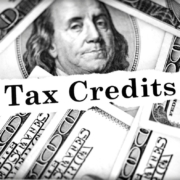Don’t Get Hit with IRS Underpayment Penalties
- Learn about the pay-as-you-earn system.
- Find information regarding withholding and payment forms.
- Discover the IRS online withholding estimator.
- Learn about situations triggering underpayments.
- Find information about safe harbor payments.
- Learn about the true safe harbor.
Under federal law, taxpayers must pay taxes during the year as they earn or receive income. Otherwise, they can find themselves falling victim to substantial underpayment penalties. Even worse, they may have spent the money. So, when tax time comes, they are unable to pay their past taxes and spiral into financial distress.
To facilitate the pay-as-you-earn concept, the government has provided several means of assisting taxpayers in meeting that requirement. These include:
- Payroll withholding for employees – W-4;
- Pension withholding for retirees – W-4P;
- Voluntary withholding for Unemployment and Social Security benefits – W-4V; and
- Estimated tax payments for self-employed individuals and those with other sources of income not covered by withholding – Form 1040-ES.

Tax withholding and estimated payments
Employees with primarily wage income can use the IRS online tool, the Tax Withholding Estimator. This can determine if their withholding closely matches their projected tax liability. If not, they need to adjust their tax withholding by providing a revised Form W-4 to their employer or risk underpayment penalties.
Employees and those with significant income from other sources, multiple jobs, rentals, side gigs, children subject to the kiddie tax, capital gains, etc., may find it appropriate to consult with their Fiducial representative for a more sophisticated tax projection and estimate of needed withholding and/or estimated tax payments.
Individuals should also check their tax withholding and estimated payments when:
- Changes in tax law affect their situation.
- They experience a lifestyle or financial change like marriage, divorce, birth or adoption of a child, home purchase, retirement, or filed Chapter 11 bankruptcy.
- They change jobs or have a change in wage income, such as when the taxpayer or their spouse starts or stops working or starts or stops a second job.
- They have taxable income not subject to withholding, such as interest, dividends, capital gains, self-employment and gig economy income, and IRA distributions.
- Reviewing their planned deductions or eligible tax credits, including items like medical expenses, taxes, interest expenses, gifts to charity, dependent care expenses, an education credit, the Child Tax Credit, or the Earned Income Tax Credit.
- Nonresident alien taxpayers should determine their tax withholding using the special instructions in Notice 1392, Supplemental Form W-4 Instructions for Nonresident Aliens.
Once an individual has determined they need to change their tax withholding, they should complete a new Form W-4 for their employer. Individuals with other types of income should provide the payor with either a new Form W-4P or Form W-4V, as applicable. Those making estimated payments can mail the payment along with Form 1040-ES to the address included on the form. They may also use the IRS online payment system to make a payment electronically.
Safe harbor rules and underpayment penalties
When a taxpayer fails to prepay a safe harbor (minimum) amount, they can be subject to the underpayment penalty. This nondeductible interest penalty is higher than what might be earned from a bank. The penalty applies quarterly, so for example, making a fourth-quarter estimated payment only reduces the fourth-quarter penalty. However, the IRS treats withholding as paid ratably throughout the year. So, increasing withholding at the end of the year can reduce the penalties for the earlier quarters. You may do this through cooperative employers. Or you could take an unqualified distribution from a pension plan, which will be subject to 20% withholding. Then, you can return the gross amount of the distribution to the plan within the 60-day statutory rollover limit.
Safe harbor amounts
Federal law and most states have so-called safe harbor rules. This means that if you comply with the rules, you won’t be penalized. There are two Federal safe harbor amounts that apply when the payments are made evenly throughout the year.
- The first safe harbor is based on the tax owed in the current year. If your payments equal or exceed 90% of your current year’s tax liability, you can escape a penalty.
- The second safe harbor—and the one taxpayers rely on most often—is based on your tax in the immediately preceding tax year. If your current year’s payments equal or exceed 100% of your prior year’s tax, you can escape a penalty, regardless of the amount of tax you may owe when you file your current year’s return. If your prior year’s adjusted gross income equaled more than $150,000 ($75,000 if you file married separate status), then your payments for the current year must equal 110% of the prior year’s tax to meet the safe harbor amount.
There is also a “de minimis amount due” of $1,000. If the amount owed is less than $1,000 the underpayment penalties do not apply.
Trouble zones
Where taxpayers get into trouble is when their income goes up or their withholding goes down for the current year versus the prior year. Examples include receiving a substantial increase in income, such as when you cash in investments, thereby increasing income but without any corresponding withholding or estimated payments. Another frequently encountered situation is when a taxpayer retires. In this case, their payroll income is replaced with pension and Social Security income without adequate withholding. Taxpayers who don’t recognize these types of situations often find themselves substantially underpaid and subject to the underpayment penalty when tax time comes around.
The bottom line is that 100% (or 110% for upper-income taxpayers) of your prior year’s total tax is the only true safe harbor. Why? Because it is based on the prior year’s tax (a known amount). Unfortunately, 90% of the current year’s tax amount is a variable based on the income for the current year. Often, that amount isn’t determined until it is too late to adjust the prepayment amounts.
When the safe harbor method doesn’t work
That being said, there are times when using the 100%/110% safe harbor method doesn’t make a lot of financial sense. For example, let’s say that in the prior year, you had a large one-time payment of income that boosted your tax to $25,000, which is $10,000 more than you normally pay. You know that you won’t have that extra income in the current year. Rather than rely on the 100%/110% of prior tax safe harbor, where you’d be prepaying $10,000 more than your current year’s tax is likely to be, it may be appropriate to use the 90% of current-year tax safe harbor, determined by making a projection of your current year tax, and as the year goes along, monitoring your income and the tax paid in to be sure you are on track to reach the 90% goal.
Pay your taxes quarterly to avoid underpayment penalties
Unlike employees, a self-employed individual must either estimate his or her net earnings for the year (or use the 100%/110% safe harbor) and pay taxes on a quarterly basis according to that estimate or safe harbor. Failure to do so will result in interest penalties.
Although these payments are called “quarterly” estimates, the periods they cover do not usually coincide with a calendar quarter.

* If the due date falls on a Saturday, Sunday, or holiday, the payment is due on the next business day.
The rules discussed apply to federal pre-payments. The rules vary for the states.
Have you had or do you expect a substantial increase in income? Then, you should contact your Fiducial representative promptly. You’ll need your withholding or estimated tax payments adjusted to avoid a penalty.
Call Fiducial at 1-866-FIDUCIAL or make an appointment at one of our office locations to discuss your situation.
Ready to book an appointment now? Click here. Know someone who might need our services? We love referrals!









